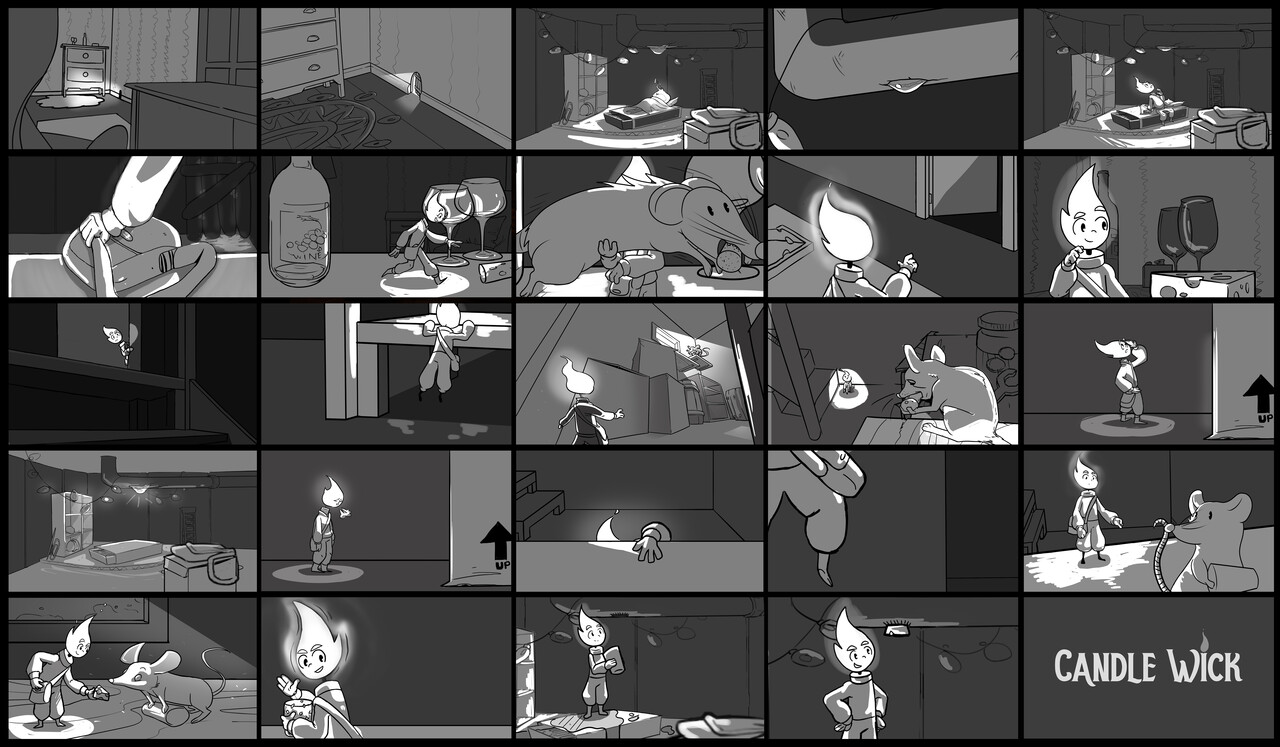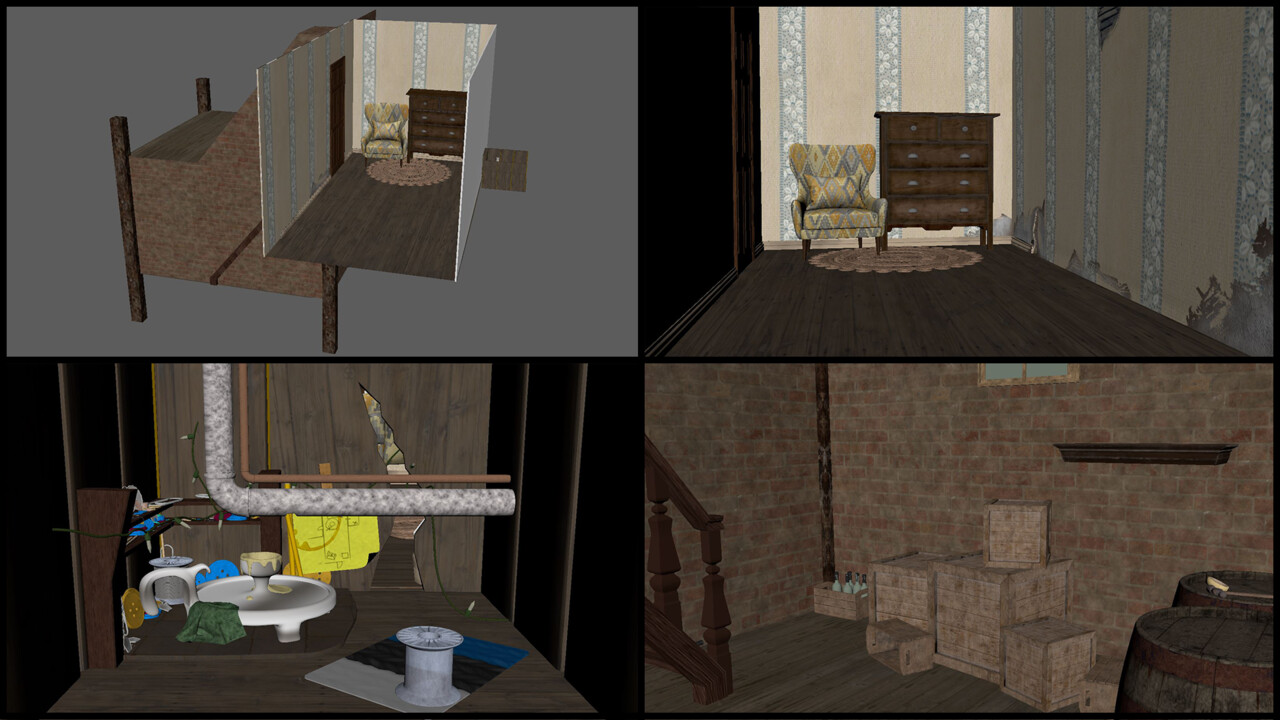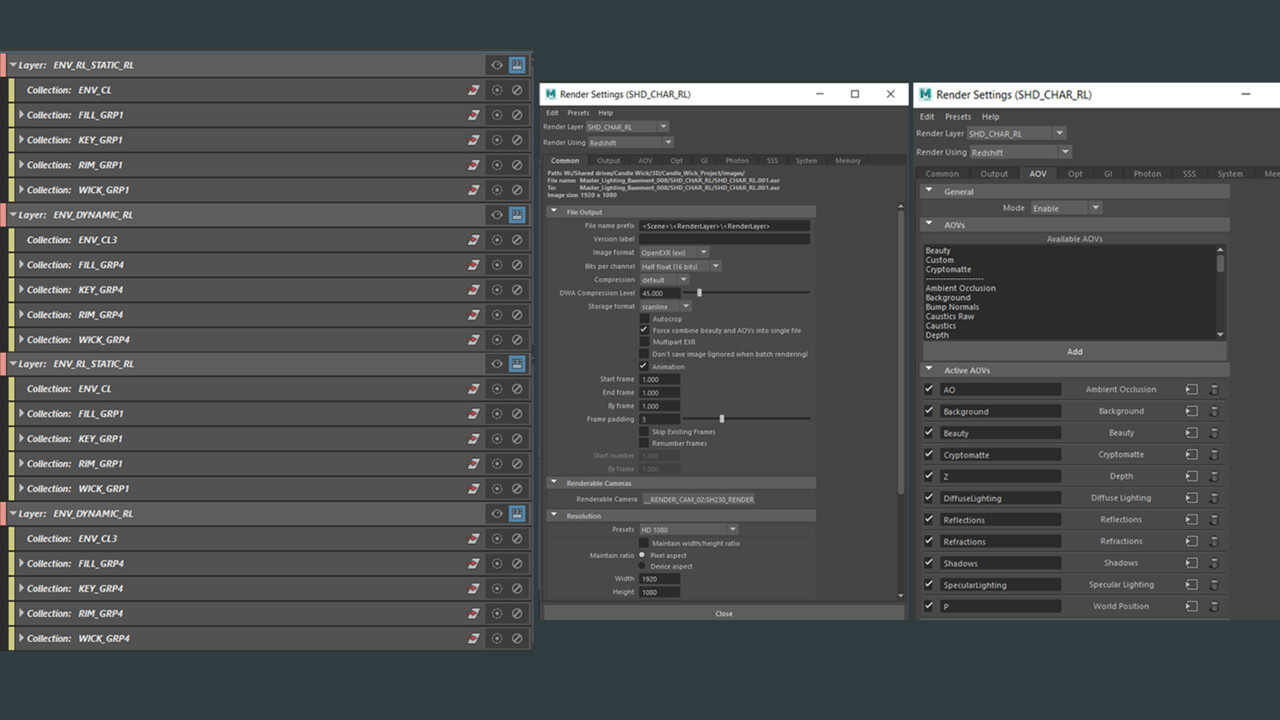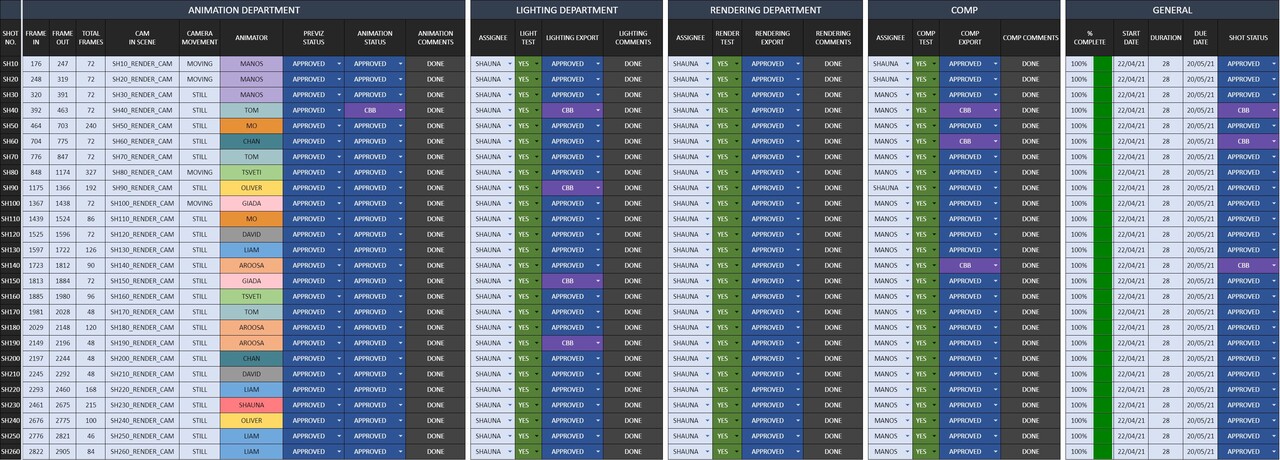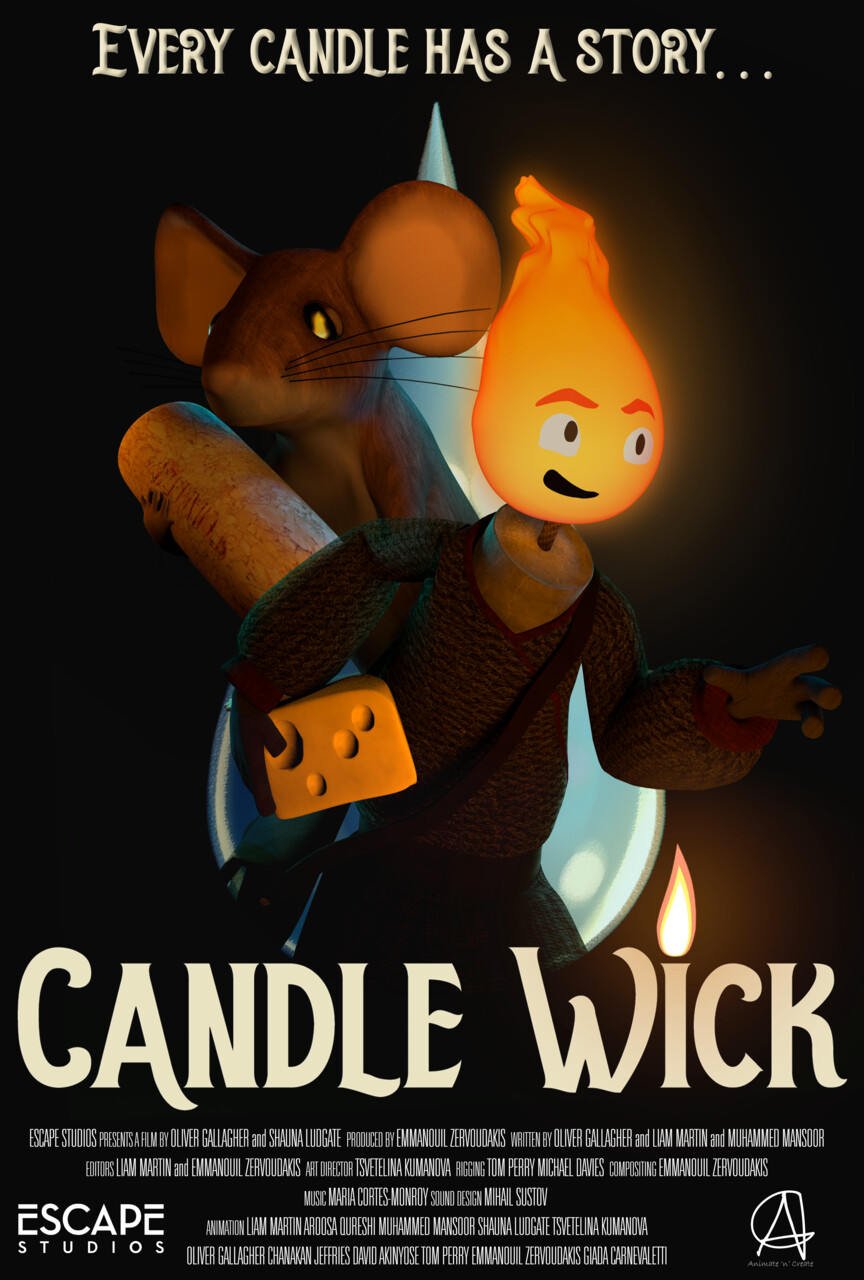ABOUT:
'Candle Wick' is an award winning, 3D animated short film which is written by Oliver Gallagher, directed by Shauna Ludgate and produced by Manos Zervoudakis, within six weeks, entirely remotely at Escape Studios in London. In the below blog I will share my experience as a Producer and a breakdown of the production process.
SHORT FILM:
The story is about an adventurous candle living inside the walls of an old house. When a water pipe inside his den started leaking, he found himself needing to go outside and find an item to block it. Being so small, every journey is a danger, even the smallest of steps, but he must risk it all when it comes to saving his home.
STORYBOARDING:
During the first two weeks, our writers and storyboarding team focused on revising the story and panels, making any necessary changes to establish a solid story before entering the production phase. By addressing any potential issues early on, we minimized the need for significant changes during later stages of production.
See the image below for our main 2D animatic panels.
COLOUR SCRIPT:
Our Art Director, Tsvetelina Kumanova, decided to go with colours like purple for the hallway to express the feeling of the unknown, orange and red for Wick's den to show the warmth of his home and finally dark bluish for the basement for its cold and dangerous environment setting.
Check out the images below to see our colour script.
CHARACTER DESIGN:
Oliver Gallagher, the Director of the short, designed Wick with the vision to have a protagonist who looked strong enough and capable of going on adventures but had an easily defined weakness. In our case he is was small, lit candle, who is totally afraid of water. He chose warm colours for his clothes like orange and yellow to push the fire aesthetic but also some grey for his hands and feet to make some body parts more distinguishable.
Click out the video below to see Wick's colour aesthetic.
MODELLING & RIGGING:
Wick was entirely modelled and rigged by Tom Perry. Creating a lit candle proved to be more challenging than initially anticipated. Tom had to explore and implement multiple techniques to provide the animators with maximum control over the character. To achieve this, he employed a set of key drivers that influenced the blend shapes of Wick's body. Additionally, he incorporated a series of optional, more advanced controls to address minute details in both the face and body.
Click the video below to see a full character turnaround in different stages.
3D LAYOUT:
Shauna Ludgate, our 3D Supervisor, undertook the task of creating the 3D Layout. This involved constructing three distinct environments: Wick's den, the hallway, and the basement, all of which she completed within the initial two weeks of the project. During the third week, she delegated the responsibility of daily maintenance, future adjustments, and troubleshooting to our modeller & rigger, Tom Perry, while she focused on supervising animation and conducting lighting tests.
Check out the below 3D Layout pictures for multiple views.
REFERENCES:
Knowing the importance of references when animating, the whole team spent a good amount of time researching examples of detailed material, as well as acting out their scenes and recording themselves for their animation.
Check the two videos below for some examples of the references we used.
ANIMATION BREAKDOWN:
To achieve a polished final result, we followed the industry-standard workflow, ensuring that all animators followed the correct steps. This involved initiating the process by blocking out the shot, then progressing to splining, and concluding with polishing.
Check out the video below to see the differences in animation between each step, from previz to the final render.
LIGHTING & RENDERING:
Shauna Ludgate, our one-woman army, was also responsible for lighting and setting up all the renders. We implemented an alembic workflow to transfer animation into the master lighting scenes which included multiple shot setups with the same environments for time efficiency. She also set up all the render layers + specific AOVs, using RedShift, which allowed us to render the backgrounds on their own while waiting for the animation to be finalized. This way we did not only save time on rendering but also gave us the power to manipulate the look of things during compositing.
See the two images below for a quick look at our lighting continuity and our render layers/settings.
COMPOSITING:
NukeX was our preferred software choice for achieving the desired results. By utilizing appropriate render layers and AOVs, we gained several technical and aesthetic advantages, including the following:
1) Allowing us to adjust the colour gradient of specific items in the environment by using crypto.
2) Manage smooth focus pulls with the Defocus node by using the Z pass.
3) Troubleshoot any issues with shadows using rotos.
You can watch the video below to see an example of a frame from Maya and then composited in Nuke.
2D FLAME PASS:
Having a realistic look for the 3D flame was very challenging so we we incorporated a 2D pass of the flame in After Effects, overlaying it onto the 3D mesh. This technique enhanced the natural deformation of the flame's edges, resulting in a more authentic look.
Check out the video below to see one of the shots in black and white, combined with the 2D flame pass.
PRODUCTION:
We mainly used Excel for production planning, scheduling and progress tracking throughout the short and had to create bespoke documents for efficient visual production management.
See the three images below for the key planning docs we used.
Production Schedule:
The Production Schedule displays all big tasks set with assignees, deadlines, and progress bars in a form of a calendar. This helped the whole team know at glance the stage of production and any pending activity.
Shot Breakdown:
This is a detailed document displaying the different shot numbers, descriptions/script, frame numbers, camera type, transitions, sounds and voiceovers. It assisted the team in different stages of pre-production such as script, storyboarding and 2D animatic.
Shot Plan:
This doc helped us manage all the different stages of production for each shot, from previz to comp. It contained automated drop lists and different status and for each step and was also colour coded to make it easily readable.
PERSONAL REFLECTION:
'Candle Wick' was very challenging and required technical knowledge to manage it. Wick was a moving light source so we needed to be proactive with our rigging process so we don't encounter too many surprises during lighting and rendering. We also dealt with internal conflict throughout the project which was very difficult to handle, especially when we entered production. By successfully producing this film, I learned how to confidently manage a difficult project when it's out of my comfort zone and how to effectively communicate throughout a project when disagreement is more common than agreement. It provided me with great experiences, technical practice and lessons which I will definitely carry over to the next project.
TEAM:
Writer & Director: Oliver Gallagher
Co-director: Shauna Ludgate
Producer: Emmanouil Zervoudakis
Art Director: Tsvetelina Kumanova
Storyboarding: Oliver Gallagher, Chanakan Jeffries, Tsvetelina Kumanova & Aroosa Qureshi
Colour Script: Tsvetelina Kumanova
3D Layout: Shauna Ludgate
Modelling & Texturing: Tom Perry & Shauna Ludgate
Rigging: Tom Perry
2D Artists: Tsvetelina Kumanova, Liam Martin & Chanakan Jeffries
Animation: Muhammed Mansoor, Tsvetelina Kumanova, Liam Martin, Oliver Gallagher, Shauna Ludgate, Aroosa Qureshi, Chanakan Jeffries, David Akinyose, Tom Perry, Emmanouil Zervoudakis & Giada Carnevaletti
Lighting & Rendering: Shauna Ludgate
Compositing: Emmanouil Zervoudakis & Shauna Ludgate
Music: Maria Cortes-Monroy
Sound Design: Mihail Sustov
Editing: Emmanouil Zervoudakis
Voice Actress: Ellie Wills

